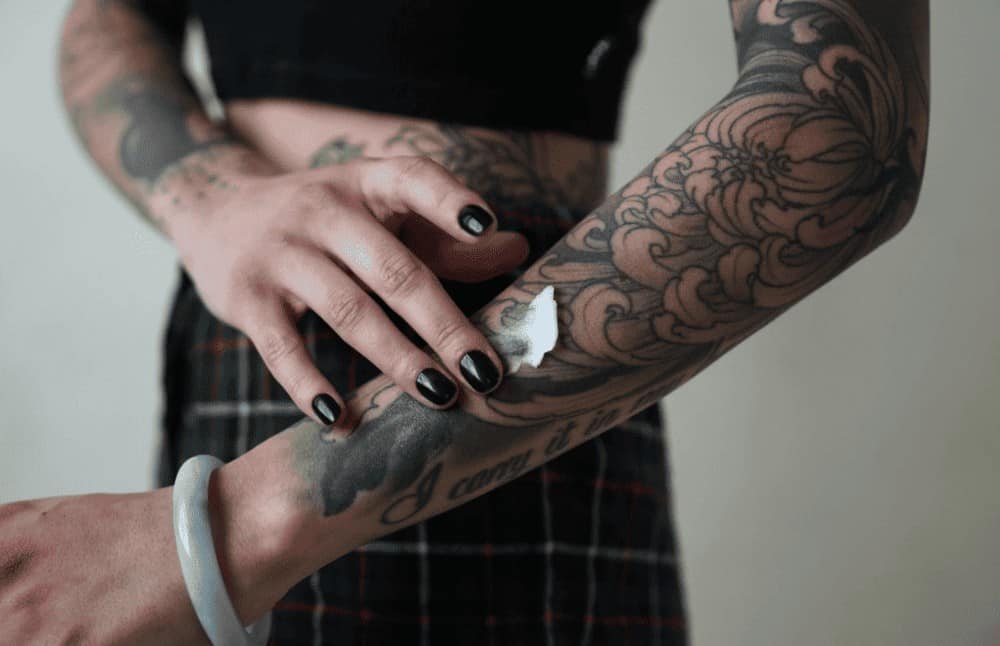Getting a new tattoo is exciting, marking both a personal choice and commitment. Proper care is crucial for the healing of your tattoo. It’s not just about the ink; it’s about safeguarding your investment so you can enjoy it to its full potential for years to come!
This blog post is your go-to guide for practical tips on ensuring your fresh tattoo heals the right way. No frills, just solid advice to keep your ink looking sharp.
Understanding the Tattoo Healing Process
Initial Inflammation and Redness
Right after getting a tattoo, expect redness and swelling around the inked area. This is your body’s natural response to the tattooing process. It’s normal, and usually lasts for a few days.
Peeling and Itching
The next phase involves peeling and itching, usually occurring after a week. Your skin sheds the top layer, revealing the new tattoo underneath. Resist the urge to scratch; instead, keep it moisturized to ease discomfort.
Final Settling and Color Stabilization
As the days pass, your tattoo will settle into its final appearance. Colors may appear dull during the peeling stage but will regain vibrancy. Ensure proper aftercare to promote optimal healing and color stabilization.
Recommended Ointments and Moisturizers
Maintaining proper moisture is crucial for tattoo aftercare. A well-moisturized tattoo promotes healing and prevents excessive dryness, reducing the risk of scabbing and irritation. Two effective options for tattoo moisturization are Aquaphor or petroleum-based ointments, known for their protective barrier and hydration properties.
Alternatively, tattoo-specific healing creams, designed with ingredients like vitamins and antioxidants, aid in skin recovery without clogging pores. Applying a thin layer of the chosen ointment or cream to the tattooed area is recommended, ensuring complete coverage without overdoing it. Frequency-wise, moisturize your tattoo 2-3 times daily, or as advised by your tattoo artist, until the healing process is complete. Remember, maintaining proper moisture is key to achieving vibrant and well-healed tattoos.
Cleaning Routines for Fresh Tattoos
Maintaining proper cleanliness is crucial for the healing of fresh tattoos. Firstly, adopt a gentle cleaning routine to minimize the risk of infection. Employ a mild, fragrance-free soap to cleanse the tattooed area, steering clear of harsh chemicals that may irritate the skin. Avoid excessive scrubbing, as it can impede the healing process. After cleaning, pat the tattoo dry with a clean cloth instead of rubbing, as this minimizes friction and reduces the chances of irritation. These straightforward steps contribute to a healthier healing process for your new tattoo.
Avoiding Common Mistakes
To ensure proper healing and longevity of your tattoo, there are a handful of common mistakes you’ll want to avoid making. Firstly, resist the urge to pick at scabs or peel skin; let the healing process occur naturally. Secondly, steer clear of direct sunlight and tanning beds, as UV rays can fade and damage the tattoo. Thirdly, refrain from prolonged water exposure, preventing soaking of the tattoo, which could hinder the healing process. Lastly, avoid wearing tight or abrasive clothing over the tattooed area to prevent irritation and promote optimal healing. Following these simple guidelines will contribute to the overall well-being and appearance of your tattoo.
General Tips for Tattoo Healing
Proper tattoo healing hinges on fundamental practices. First off, hydration and nutrition play a pivotal role. Drink plenty of water and maintain a balanced diet rich in vitamins and minerals to boost the body’s healing mechanisms. Steer clear of intense physical activities that could aggravate the tattooed area; give it the space to recover undisturbed. Equally crucial is ensuring sufficient sleep—this fosters a conducive environment for the body’s natural healing processes. In essence, prioritize hydration, nutrition, and adequate rest to facilitate a smooth and swift healing journey for your tattoo.
Dealing with Itching and Discomfort
To address itching and discomfort after getting a tattoo, follow these straightforward steps. First, apply the anti-itch cream recommended by your tattoo artist. This helps soothe irritation and promotes healing. Resist the urge to scratch or rub the tattoo, as this can hinder the healing process and increase the risk of infection. If itching persists, consider using cold compresses to relieve discomfort. These measures contribute to a smoother healing experience and better overall results for your tattoo.
Monitoring for Signs of Infection
Monitoring for signs of infection is crucial for early detection and prompt intervention. Red flags include persistent fever, increasing pain, or unusual fatigue. Keep an eye on changes in skin color, swelling, or discharge from wounds. If you notice these symptoms, it’s important to seek professional medical advice promptly. Additionally, pay attention to respiratory issues like persistent cough, shortness of breath, or chest pain. Any sudden changes in bowel habits or urinary patterns also warrant attention. Trust your instincts—if something feels off, consult a healthcare professional. Timely intervention enhances the chances of effective treatment and recovery. Don’t hesitate to seek medical advice when in doubt about potential signs of infection.
Conclusion
Nurturing a vibrant and well-healed tattoo demands commitment to fundamental care practices. Remember, embrace the unique journey of your healing process, exercise patience, and prioritize essential steps like moisturization, cleanliness, and avoiding common mistakes. Your diligence ensures not just ink on skin but a lasting testament to your personal commitment and self-expression.
